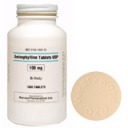AMINOPHYLLINE
MECHANISM OF ACTION
This drug acts by relaxing bronchial smooth muscle, causing bronchodilation and increasing vital capacity, which has been impaired by bronchospasm and air trapping; in higher concentrations, it also inhibits the release of slow-reacting substance of anaphylaxis (SRS-A) and histamine.
INDICATIONS
This is indicated for symptomatic relief or prevention of bronchial asthma and reversible bronchospasm associated with chronic bronchitis and emphysema
CONTRAINDICATIONS
This drug is contraindicated with hypersensitivity to any xanthine or to ethylenediamine, peptic ulcer, active gastritis; rectal or colonic irritation or infection (use rectal preparations). Use cautiously with cardiac arrhythmias, acute myocardial injury, CHF, cor pulmonale, severe hypertension, severe hypoxemia, renal or hepatic disease, hyperthyroidism, alcoholism, labor, lactation, pregnancy.
SIDE EFFECTS
Serum theophylline levels < 20 mcg/mL: Adverse effects uncommon
Serum theophylline levels > 20–25 mcg/mL: Nausea, vomiting, diarrhea, headache, insomnia, irritability (75% of patients)
Serum theophylline levels > 30–35 mcg/mL: Hyperglycemia, hypotension, cardiac arrhythmias, tachycardia (> 10 mcg/mL in premature newborns); seizures, brain damage
CNS: Irritability (especially children); restlessness, dizziness, muscle twitching, seizures, severe depression, stammering speech; abnormal behavior characterized by withdrawal, mutism, and unresponsiveness alternating with hyperactive periods
CV: Palpitations, sinus tachycardia, ventricular tachycardia, life-threatening ventricular arrhythmias, circulatory failure
GI: Loss of appetite, hematemesis, epigastric pain, gastroesophageal reflux during sleep, increased AST
GU: Proteinuria, increased excretion of renal tubular cells and RBCs; diuresis (dehydration), urinary retention in men with prostate enlargement
Respiratory: Tachypnea, respiratory arrest
Other: Fever, flushing, hyperglycemia, SIADH, rash
DRUG-DRUG INTERACTIONS
1. Increased effects with cimetidine, erythromycin, troleandomycin, clindamycin, lincomycin, influenza virus vaccine, fluoroquinolones, hormonal contraceptives;
2. Possibly increased effects with thiabendazole, rifampin, allopurinol;
3. Increased cardiac toxicity with halothane; increased likelihood of seizures when given with ketamine; increased likelihood of adverse GI effects when given with tetracyclines;
4. Increased or decreased effects with furosemide, levothyroxine, liothyronine, liotrix, thyroglobulin, thyroid hormones;
5. Decreased effects in patients who are cigarette smokers (1–2 packs per day); theophylline dosage may need to be increased 50%–100%;
6. Decreased effects with phenobarbital, aminoglutethimide;
7. Increased effects, toxicity of sympathomimetics (especially ephedrine) with theophylline preparations;
8. Decreased effects of phenytoin and theophylline preparations when given concomitantly;
9. Decreased effects of lithium carbonate, nondepolarizing neuromuscular blockers given with theophylline preparations; and
10. Mutually antagonistic effects of beta-blockers and theophylline preparations
DRUG-FOOD INTERACTIONS
1. Elimination is increased by a low-carbohydrate, high-protein diet and by charcoal-broiled beef;
2. Elimination is decreased by a high-carbohydrate, low-protein diet; and
3. Food may alter bioavailability and absorption of timed-release theophylline preparations, causing toxicity; these forms should be taken on an empty stomach
DRUG-LAB TEST INTERACTIONS
1. Interference with spectrophotometric determinations of serum theophylline levels by furosemide, phenylbutazone, probenecid, theobromine; coffee, tea, cola beverages, chocolate, acetaminophen cause falsely high values; and
2. Alteration in assays of uric acid, urinary catecholamines, plasma free fatty acids by theophylline preparations
NURSING CONSIDERATIONS
Assessment
History: Hypersensitivity to any xanthine or to ethylenediamine, peptic ulcer, active gastritis, cardiac arrhythmias, acute myocardial injury, CHF, cor pulmonale, severe hypertension, severe hypoxemia, renal or hepatic disease, hyperthyroidism, alcoholism, labor, lactation, rectal or colonic irritation or infection (aminophylline rectal preparations)
Physical: Bowel sounds, normal output; P, auscultation, BP, perfusion, ECG; R, adventitious sounds; frequency of urination, voiding, normal output pattern, urinalysis, LFTs, renal function tests; liver palpation; thyroid function tests; skin color, texture, lesions; reflexes, bilateral grip strength, affect, EEG
Interventions
1. Administer to pregnant patients only when clearly needed—neonatal tachycardia, jitteriness, and withdrawal apnea observed when mothers received xanthines up until delivery;
2. Give immediate-release, liquid dosage forms with food if GI effects occur;
3. Do not give timed-release forms with food; these should be given on an empty stomach 1 hr before or 2 hr after meals;
4. Maintain adequate hydration;
5. Monitor results of serum theophylline levels carefully, and arrange for reduced dosage if serum levels exceed therapeutic range of 10–20 mcg/mL;
6. Take serum samples to determine peak theophylline concentration drawn 15–30 min after an IV loading dose;
7. Monitor for clinical signs of adverse effects, particularly if serum theophylline levels are not available; and
8. Ensure that diazepam is readily available to treat seizures.
Teaching points
1. Caution patient not to chew or crush enteric-coated timed-release forms;
2. Take this drug exactly as prescribed; if a timed-release product is prescribed, take this drug on an empty stomach, 1 hour before or 2 hours after meals;
3. Do not to chew or crush timed-release preparations;
4. Administer rectal solution or suppositories after emptying the rectum;
5. It may be necessary to take this drug around-the-clock for adequate control of asthma attacks;
6. Avoid excessive intake of coffee, tea, cocoa, cola beverages, and chocolate;
7. Smoking cigarettes or other tobacco products impacts the drug's effectiveness. Try not to smoke. Notify your health care provider if smoking habits change while taking this drug;
8. Frequent blood tests may be necessary to monitor the effect of this drug and to ensure safe and effective dosage; keep all appointments for blood tests and other monitoring;
9. You may experience these side effects: Nausea, loss of appetite (taking this drug with food may help if taking the immediate-release or liquid dosage forms); difficulty sleeping, depression, emotional lability (reversible); and
10. Report nausea, vomiting, severe GI pain, restlessness, seizures, irregular heartbeat.
REFERENCES:
Aminophylline Image. http://www.1800petmeds.com/images/products/large/10045_160.jpg
Karch, Amy M. Lippincott Williams & Wilkins. 2007 Nursing Drug Guide.
HOME | A-B | C-D | E-F | G-H | I-J | K-L | M-N | O-P | Q-R | S-T | U-V | W-X | Y-Z | HOME
This is a free website hosted by weebly.
This is created for Student Nurses by blue_identity.

